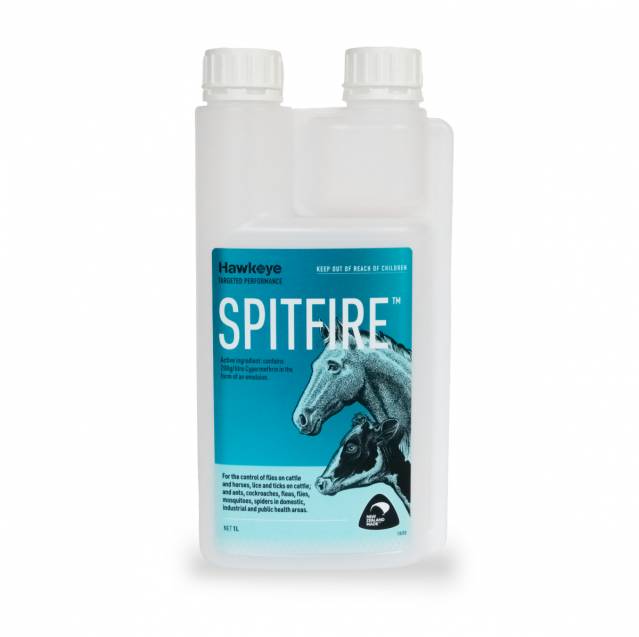Directions for use:
For Fly control on horses and cattle:
Apply 50ml SPITFIRE in 10 litres of water.
Adult cattle and horses – 500ml spray, young cattle – 250ml spray, and calves/ ponies 125ml spray.
Use a suitable sprayer with a nozzle providing a medium fine to fine spray but avoid fogging. Spray to cover all parts of the animal. In the case of cattle, the application can be made by way of a hooped spray boom mounted over the exit race from dairy sheds/yards. The application should commence at the onset of the fly season (November) and be repeated as necessary, usually at monthly intervals.
For Lice and Tick control on Cattle:
Apply 75ml SPITFIRE in 100 litres of water.
Use a standard spray dip/recirculating shower or hand sprayer if appropriate.
SHAKE WELL BEFORE USE. Spray mixtures should be used within 24 hours if unagitated. Spray mixtures may be stored for up to 5 days if agitated before use.
Withholding periods - it is an offense for users of this product to cause residues exceeding the relevant MRL in the Food Notice: Maximum Residue Levels for Agricultural Compounds.
MEAT: Cattle producing meat or offal for human consumption must not be sold for slaughter either during or within 24 days of the last treatment. Horses producing meat or offal for human consumption must not be sold for slaughter either during or within 63 days of the last treatment.
MILK: Withholding period – nil
Technical Information:
Spitfire is a new generation water-based microemulsion formulation containing 200g/L Cypermethrin. Unlike other Cypermethrin products available Spitfire contains no Xylene and is non-flammable, reducing the risk to users when handling the product.
Spitfire has a reduced level of solvent due to it being water-based and is in a convenient 1L HDPE pack with an included measuring cylinder that is fully recyclable through Agrecovery.
Spitfire is approved for control of flies on cattle and horses, and lice and ticks on cattle. It is registered pursuant to the ACVM Act 1997, No. A011718
Spitfire can also be used to control a variety of insect pests in and around buildings making it an excellent all-rounder in rural settings.
Cypermethrin is a Type II synthetic pyrethroid with broad-spectrum activity on a variety of insect pests. Its mode of action is as a sodium channel modulator which can be described as holding open sodium channels in insect nerve cells, causing repeated firing of nerve signals, overstimulation, and mortality. Mammalian nerve cells are different enough that Synthetic Pyrethroids have reduced toxicity to mammals in comparison to insects. Cypermethrin is still a hazardous substance so users should always familiarise themselves with labeled safety, handling, and usage instructions.
Cypermethrin has had a long history of use on cattle and horses, Spitfire capitalizes on, and modernises these uses through its advanced microemulsion formulation. As well as being water based, a microemulsion is kinetically stable meaning that a spray mix dilution has infinite physical stability1. The very small size of microemulion oil droplets (typically around 0.1µm) means a more homogeneous spray mixture than a traditional emulsion and much greater surface area, which in turn increases the chance of an insect contacting the active ingredient and being exposed to a lethal dose.
Spray mixtures may be stored for up to 5 days if agitated prior to use.

